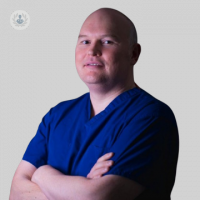What is an endoscopy for a hiatus hernia? An expert guide to the procedure
Autore:A hiatus hernia can often lead to symptoms and health complications. Diagnosing this condition accurately is thus crucial for determining the best treatment option, and an endoscopy is the most effective method for doing so.
Professor Ewen Griffiths, renowned consultant upper GI and general surgeon, explains what is an endoscopy for a hiatus hernia, why it’s the preferred diagnostic tool, and what patients can expect during and after the procedure.

What is a hiatus hernia?
A hiatus hernia occurs when part of the stomach protrudes through the hiatus (an opening in the diaphragm) into the chest cavity. This condition often leads to symptoms like heartburn, acid reflux and chest pain, although some patients may be asymptomatic.
Why is an endoscopy the primary method for diagnosing a hiatus hernia?
An endoscopy, specifically an upper gastrointestinal (GI) endoscopy, is a non-surgical procedure that uses an endoscope (a long, thin, flexible tube with a tiny camera) to examine the oesophagus, stomach, diagram, and other parts of the digestive tract.
An endoscopy is one of the most accurate and commonly-used procedures to diagnose a hiatus hernia. While other diagnostic tools such as barium swallow X-rays or a manometry can also help detect hiatus hernias, an endoscopy is particularly effective because it:
- Provides detailed, high-resolution images of the digestive system.
- Detects not just the presence of a hernia but also any accompanying complications like oesophagitis (inflammation of the oesophagus) or Barrett's oesophagus (a precancerous condition).
- Allows your surgeon to take biopsies (tissue samples) if needed, which is especially useful if other underlying conditions are suspected.
Moreover, an endoscopy can also assess gastroesophageal reflux disease (GERD) severity, a condition that frequently accompanies a hiatus hernia.
How is an endoscopy for a hiatus hernia performed?
An endoscopy is a simple, minimally invasive procedure. To prepare for the endoscopy, you will be instructed to fast for 6-8 hours before the procedure to ensure that the stomach is empty and provides a clear view for your surgeon. Additionally, you will also need to inform your surgeon about any medications you are taking, as some drugs may need to be adjusted.
The actual endoscopy takes around 5 to 10 minutes. You will be given the choice of either local anaesthetic, spray alone, with or without sedation (given via a drip) to help you relax and minimise any discomfort. If the procedure is simple and diagnostic only, lots of patients manage the procedure awake with only local anaesthetic spray. If the procedure is more complex or you are anxious or have had a previous bad experience with an endoscopy, sedation is normally recommended.
After administering sedation, your surgeon will carefully guide the endoscope through your mouth, guiding it down the oesophagus and into the stomach. The attached camera will then send high-quality images to a monitor, allowing your surgeon to examine the oesophagus, stomach, and the diaphragm's hiatus for signs of a hernia. In some cases, your surgeon will also check for any erosion caused by stomach acid and, if necessary, take biopsies from any abnormal areas.
Once the endoscopy is complete, you will be monitored whilst the sedation wears off. Most patients will need to rest for about an hour before they can go home. Afterwards, you will need to arrange for someone to drive you home.
Is an endoscopy painful?
Thanks to the sedation and local anaesthetic, most patients experience only minimal discomfort during the procedure. The endoscope itself is also very thin and flexible, and while it may feel unusual as it moves through the digestive tract, it shouldn't cause pain.
What will happen after the endoscopy?
After the endoscopy, your surgeon will review the findings and discuss them with you. If a hiatus hernia is confirmed, the next step is determining the most appropriate course of treatment based on the size of the hernia, your symptoms, and any damage caused by acid reflux.
Lifestyle changes
For many patients with mild symptoms, lifestyle modifications are the first line of treatment. This may include changes to diet, avoiding heavy meals, eating smaller portions, and avoiding lying down after eating. Weight management and quitting smoking can also help reduce symptoms.
Medications
Patients experiencing severe heartburn or acid reflux may be prescribed antacids, H2 blockers, or proton pump inhibitors (PPIs) to reduce stomach acid production and relieve symptoms.
Surgery
In more severe cases, particularly if the hernia is large or leading to significant complications, surgical intervention may be advised. The most common surgical procedure for repairing a hiatus hernia is a keyhole procedure with formation of a new value or fundoplication. During this procedure, your surgeon will tighten the opening of the diaphragm and wrap part of the stomach around the lower oesophagus to prevent reflux. A common operation type is a Nissen fundoplication which is a 360 degree valve, but others such as a Toupet fundoplication form a 270 degree valve. Newer procedures include LINX® and RefluxStop™. It's important that your upper GI surgeon can discuss the pros and cons of each different surgical procedure to help you choose what is best for you.
If you would like to book an appointment with Professor Ewen Griffiths, head on over to his Top Doctors profile today.


